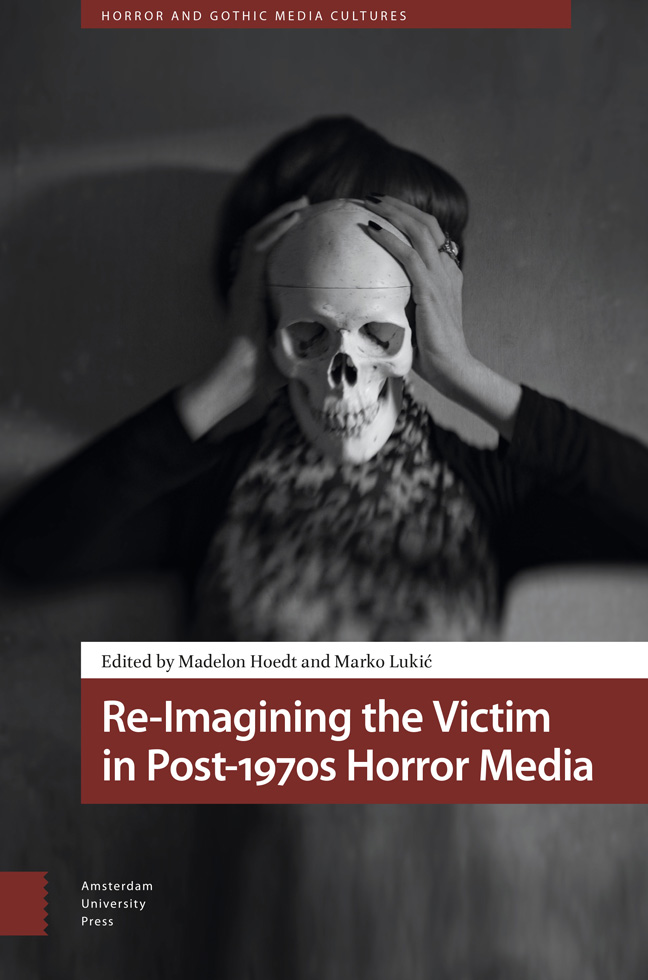Book contents
- Frontmatter
- Contents
- Introduction: Theorising the Victim
- 1 Opening the Gate: Reconfiguring the Child Victim in Stranger Things
- 2 Black Death: Black Victims in 1980s Teen Slashers
- 3 Beyond Binaries: The Position of the Transgender Victim in Horror Narratives
- 4 Through the Looking-Glass: The Gothic Victim in Jordan Peele’s Us
- 5 Postmortem Victimhood: Necrovalue in Phantasm and Dead and Buried
- 6 The Sad Killer: Perpetuating Spaces, Trauma and Violencewithin the Slasher Genre
- 7 “If this is the last thing you see… that means I died”: A Taxonomy of Camera-Operating Victims in Found Footage Horror Films
- 8 Victimhood and Rhetorical Dialectics within Clive Barker’s Faustian Fiction
- 9 Pain Index, Plain Suffering and Blood Measure: A Victimology of Driving Safety Films, 1955–1975
- 10 Biolithic Horror: Stone Victim/Victimisers in Resident Evil Village
- 11 The Potential Victim: Horror Role-Playing Games and the Cruelty of Things
- Bibliography
- Filmography
- Index
1 - Opening the Gate: Reconfiguring the Child Victim in Stranger Things
Published online by Cambridge University Press: 26 March 2024
- Frontmatter
- Contents
- Introduction: Theorising the Victim
- 1 Opening the Gate: Reconfiguring the Child Victim in Stranger Things
- 2 Black Death: Black Victims in 1980s Teen Slashers
- 3 Beyond Binaries: The Position of the Transgender Victim in Horror Narratives
- 4 Through the Looking-Glass: The Gothic Victim in Jordan Peele’s Us
- 5 Postmortem Victimhood: Necrovalue in Phantasm and Dead and Buried
- 6 The Sad Killer: Perpetuating Spaces, Trauma and Violencewithin the Slasher Genre
- 7 “If this is the last thing you see… that means I died”: A Taxonomy of Camera-Operating Victims in Found Footage Horror Films
- 8 Victimhood and Rhetorical Dialectics within Clive Barker’s Faustian Fiction
- 9 Pain Index, Plain Suffering and Blood Measure: A Victimology of Driving Safety Films, 1955–1975
- 10 Biolithic Horror: Stone Victim/Victimisers in Resident Evil Village
- 11 The Potential Victim: Horror Role-Playing Games and the Cruelty of Things
- Bibliography
- Filmography
- Index
Summary
Abstract
The hit Netflix original series Stranger Things (2016–) cites several influential horror texts which depict children either as passive victim or monstrous threat. Children frequently occupy these polarised positions in horror films aimed at adult audiences, exposing adult fears over the child’s growing social power, knowledge and autonomy. With young as well as adult viewers in mind, Stranger Things self-consciously sets out to avoid the ideological trappings of its resurrected horror texts, mobilising its informing sources not just for nostalgia but also for reflection and critique. This chapter explores how Stranger Things initiates a shift from the child’s long-established position as horror victim to actively engaged horror participant.
Keywords: Duffer Brothers, children, horror, trauma, monster, Netflix
Set in the 1980s, the hit Netflix original series Stranger Things (The Duffer Brothers, 2016–) cites many influential horror texts from the period, where children feature either as passive victims or monsters masquerading under the guise of childhood innocence. In a flashback from the opening episode, Joyce Byers (Winona Ryder) presents her twelve-year-old son Will (Noah Schnapp) with tickets to see Tobe Hooper’s Poltergeist (1982), a film about a helpless child who disappears through a television set and is held at the mercy of evil spirits (ST 1.1). Like Carol Anne (Heather O’Rourke) in Poltergeist, Will disappears inside a frightening parallel realm known as the Upside Down, where he must hide from a carnivorous monster until Joyce finds him and brings him home. In the show’s second season, Will becomes possessed by a dangerous entity referred to by his friends as the Mind Flayer (ST 2.8) and recalls “an icon in American mass culture” which reached popularity in 1970s horror cinema (Schober 12). Textual allusions to demonic child films such as The Exorcist (Friedkin, 1973), The Omen (Donner, 1976) and Children of the Corn (Kiersch, 1984) feature in several episodes, as Will, although appearing as himself, now poses a threat to those around him and the lives of his friends and family.
Children frequently occupy these polarised positions in horror films aimed at adult audiences, with the victim-monster binary exposing adult fears of losing a child to monstrous forces or a turn to monstrosity, but also to the child’s growing social power, knowledge and autonomy.
- Type
- Chapter
- Information
- Re-Imagining the Victim in Post-1970s Horror Media , pp. 19 - 38Publisher: Amsterdam University PressPrint publication year: 2024



